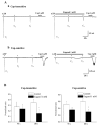Eugenol Inhibits ATP-induced P2X Currents in Trigeminal Ganglion Neurons
- PMID: 19967073
- PMCID: PMC2788653
- DOI: 10.4196/kjpp.2008.12.6.315
Eugenol Inhibits ATP-induced P2X Currents in Trigeminal Ganglion Neurons
Abstract
Eugenol is widely used in dentistry to relieve pain. We have recently demonstrated voltage-gated Na(+) and Ca(2+) channels as molecular targets for its analgesic effects, and hypothesized that eugenol acts on P2X(3), another pain receptor expressed in trigeminal ganglion (TG), and tested the effects of eugenol by whole-cell patch clamp and Ca(2+) imaging techniques. In the present study, we investigated whether eugenol would modulate 5'-triphosphate (ATP)-induced currents in rat TG neurons and P2X(3)-expressing human embryonic kidney (HEK) 293 cells. ATP-induced currents in TG neurons exhibited electrophysiological properties similar to those in HEK293 cells, and both ATP- and alpha ,beta-meATP-induced currents in TG neurons were effectively blocked by TNP-ATP, suggesting that P2X(3) mediates the majority of ATP-induced currents in TG neurons. Eugenol inhibited ATP-induced currents in both capsaicin-sensitive and capsaicin-insensitive TG neurons with similar extent, and most ATP-responsive neurons were IB4-positive. Eugenol inhibited not only Ca(2+) transients evoked by alpha ,beta-meATP, the selective P2X(3) agonist, in capsaicin-insensitive TG neurons, but also ATP-induced currents in P2X(3)-expressing HEK293 cells without co-expression of transient receptor potential vanilloid 1 (TRPV1). We suggest, therefore, that eugenol inhibits P2X(3) currents in a TRPV1-independent manner, which contributes to its analgesic effect.
Keywords: ATP; Eugenol; P2X receptor; Trigeminal ganglion neurons.
Figures




References
-
- Alavi AM, Dubyak GR, Burnstock G. Immunohistochemical evidence for ATP receptors in human dental pulp. J Dent Res. 2001;80:476–483. - PubMed
-
- Bleehen T, Keele CA. Observations on the algogenic actions of adenosine compounds on the human blister base preparation. Pain. 1977;3:367–377. - PubMed
-
- Burnstock G. A unifying purinergic hypothesis for the initiation of pain. Lancet. 1996;347:1604–1605. - PubMed
-
- Burnstock G, Wood JN. Purinergic receptors: their role in nociception and primary afferent neurotransmission. Curr Opin Neurobiol. 1996;6:526–532. - PubMed
-
- Burnstock G. Purinergic P2 receptors as targets for novel analgesics. Pharmacol Ther. 2006;110:433–454. - PubMed
LinkOut - more resources
Full Text Sources
Miscellaneous

